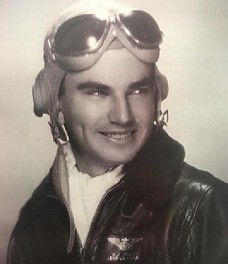


 |
 |
 |


Roadrunners International and the Nevada Aerospace Hall of Fame are saddened to learn that Lockheed Experimental Test Pilot Ray J. Goudey (1921 - 2019) took his final flight on 28 February 2019. Goudey was the 2nd pilot to fly the U-2 at Area 51 after Tony Levier. He subsequently flew the 1st flights on the U-2B and U-2C models, establishing an extraordinary aviation legacy with too many accomplishments to list.
Ray is survived by his wife Jeri and is from Genova, Nevada.
 Ray Jewett Goudey: Fellow, Society of Experimental Test Pilots, born 25 September 1921 and died on 28 February 2019 at the age of 97. Preceded in death by his daughter Starr, he is survived by his wife, Jeanette, his sons, Tyson, Sky, and Ray Jr., his daughters, Rayna and Candyce, his stepson Kevin and stepdaughter Jackie, his brother Charles, and sister Jane.
Ray Jewett Goudey: Fellow, Society of Experimental Test Pilots, born 25 September 1921 and died on 28 February 2019 at the age of 97. Preceded in death by his daughter Starr, he is survived by his wife, Jeanette, his sons, Tyson, Sky, and Ray Jr., his daughters, Rayna and Candyce, his stepson Kevin and stepdaughter Jackie, his brother Charles, and sister Jane.
Ray Goudey was born in Los Angeles and graduated from John Marshall High School. He was an Eagle Scout. After his dad bought him a ride in a Ford Trimotor, Ray knew he was meant to fly, soloing on his 16th birthday, and going on in his life to attain every airplane rating and helicopter rating that exists, and a designated flight examiner in all. He flew 258 different makes and models, including 74 designed and built by Lockheed, and has 23,708 hours of flying time in his logbook, which doesn't include over a thousand hours in classified CIA programs he wasn't permitted to log while working as a civilian for the Department of Defense. He was honored at CIA headquarters in Langley, VA on July 30, 2004 for his special service at a critical time in Cold War history.
A flight instructor from 1940 to 1943, Ray entered the U.S. Navy in 1943 as an ensign, and flew the F4F in production flight tests, as well as production aircraft from Chance Vought, Curtis, and the US Naval Factory. He was promoted to Lieutenant Junior Grade in 1945, and to Lieutenant in 1948. Ray was a favorite performer with the Sammy Mason's Hollywood Hawks, flying his Aeronca Champ drunk farmer act, and showing off his famous outside snap rolls. He served as chief pilot for Hank Coffin Flying Service. He was hired by Lockheed in 1952 and did production testing of the T-33A, F-80A, and F-94. Ray was third behind Tony Levier and 'Fish' Salmon to fly the XF-104, and was developmental test pilot on that program, setting a speed record of 1.75 Mach in 1954. He was third to fly the U-2, and amassed 2200 hours in the U-2's early years through all phases of development and classified deployment. He was the chief test pilot on the L-329 Jetstar and Kelly Johnson's personal pilot from 1956 to 1982, also serving as engineering test pilot on the Electra, RC-121, P-3A, and follow-on models of the F-104, and the U-2.
From 1961 to 1972, Ray was Lockheed's helicopter engineering test pilot during the development of the CL-475, XH-51A, L-286, the CL186C, in which he set a speed record of 262 knots, and the AH-56A Cheyenne helicopter.
From 1972 to 1977, Ray and Chief Pilot John Christiansen performed most of the testing of the highly successful S-3A Viking. From 1978 to 1990, Ray worked on several Lockheed Skunk Works classified programs, including Have Blue, the prototype for the F-117.
The family will hold private memorial services for Ray at a date to be determined.
 |
 |
 |